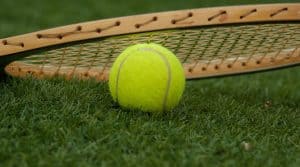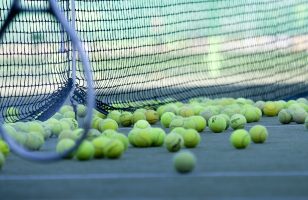What are the best tennis balls?
With the multitude of tennis ball choices out there the question is, which tennis ball is the best? The short, truest answer is ANY BALL AVAILABLE! The long, informed answer includes factors such as court type, quality, feel, life expectancy, cost, and even health plays a role. The tennis ball is just one thing that needs to be in our bag of tennis gear, but along with a racket is one of the most important. Without the tennis balls there is no tennis match.
The Choices Include:
Penn Championship
This is my top choice. Available in extra duty, extra duty high altitude, or regular duty. These options are detailed below for use in different circumstances. It’s the official ball of USTA leagues. These are leagues played at clubs at the amateur level sanctioned by the USTA. This ball is available at most clubs.
Wilson Regular Duty
This is a great all around ball. It plays best on softer surfaces such as clay, grass, and carpet but holds up well on hard courts as well. It is used in the U.S. Open as well as the Australian Open.
Dunlop ATP Premium Extra Duty
This ball is great for hard courts. It has superb durability and is used in the ATP World Tour.
Penn Tour Extra Duty
This ball is great for hard courts as well. It is durable and remains consistent throughout the match.
Penn Championship High Altitude
This ball carries the same characteristics as the Penn Championship ball but is better suited for the higher altitudes (above 4000 feet).
High altitude balls, while carrying the same rules requirements for dimensions and mass as fast and medium balls, have a lower bounce rate than those balls, offsetting the lack of air pressure on the ball which would allow a standard ball to travel through the air with slightly less resistance, possibly allowing the ball to go farther and a touch faster.
Tennis Balls For Kids
Penn QST 36
This ball is for level 3 junior players. It is the best type of ball to start any beginner at. The travel speed is slower than a typical ball and is meant to be played on a smaller court or in closer proximity to the other player. It is best for beginners 5-7.
Wilson US Open Starter
This ball is for level 2 junior players. One step closer to regular balls. It is best for ages 8-9.
Gamma Sports 78
This ball is for level 1 junior players who are making the move to a regular size tennis court. It is meant for ages 9-10. It still has a slower rate than the regular tennis balls, but is much closer to the real thing.

You’ve Got Tennis Ball Questions, We’ve Got Tennis Ball Answers
How Much Do Tennis Balls Cost?
Generally speaking, there are three tennis balls in a can and a can will cost anywhere from $5-$9, but sales can commonly be found as low as $3.25. You can also purchase a case of tennis balls (12 cans with 3 balls in each can=36 balls) for $50-$70.
How Long Do Tennis Balls Last?
When playing a match it is standard practice to buy 1 new can of tennis balls approved by the USTA or agreed upon in advance by the players. The expectation is those balls will last around 3 hours before it becomes noticeably flat. This is a broad general rule of thumb, and I certainly have used balls that have many more hours of life on them than 3. But, a sanctioned match must have consistent balls in play and it is good etiquette not to skirt this.
An unopened can of pressurized tennis balls presumably will last indefinitely. I imagine even this has a shelf life, however long it might take to get there.
What are Tennis Balls Made Out Of?
Tennis balls are made from a hollow rubber core injected with pressurized air. That core is covered with felt pressed on and made from wool or nylon. There are differences in the felt and the amount of felt on the balls and that makes a huge difference in playability.
What Type of Balls Work Best For Hard, Grass, and Clay Courts?
The heavy duty or extra duty tennis balls work the best for hard courts. They have more felt on the balls, which will allow them to resist wear and tear throughout the match. The more felt that begins on the ball the more felt left on the ball as the match plays on.
The regular duty or light duty tennis balls work the best for softer surfaces such as clay, grass, and carpet. These courts are less abrasive and therefore less felt is needed to resist the wear and tear. Consequently extra duty balls can turn in to an annoyance and even a detriment on clay courts. The tendency of the clay itself getting caught in the extra felt changes the play of the ball dramatically and also creates a heavier ball, which could be more difficult to play with and even promote injuries such as tennis elbow.
Tennis Balls are Pressurized?
Yes, they are! They are pressurized typically to 12 pounds per square inch. There is a rule for approval that the tennis ball tested must bounce between 53 inches and 58 inches at sea level when dropped from 100 inches onto a concrete surface.
Are All Tennis Balls Pressurized?
There are tennis balls that aren’t pressurized. These are called pressureless tennis balls. They are made with a solid rubber core allowing to have a similar bounce and usage as a pressurized ball. Keep in mind ‘similar’ is not ‘the same as’. A pressureless ball will have more rubber and therefore be heavier than a standard pressurized tennis ball. This heavier ball could lead to more problems with arm fatigue, tennis elbow, and other injuries. It will bounce differently, even if subtly, and react differently when struck. The benefit of course is life of the ball. It will stay consistent with it’s bounce far longer than pressurized balls.
How Big are Tennis Balls?
Fast, medium, and high altitude tennis balls all carry standard dimensions. The diameter is 2.57″-2.70″ (6.54cm-6.86cm). The mass of the balls are 1.98oz-2.10oz (56.0-59.4 grams). For slow play tennis balls the diameter runs between 2.76″-2.87″ (7.00cm-7.30cm). That is the only dimensional change to the slow play ball.
How To Keep Tennis Balls?
Whatever tennis ball you use, keeping them at a consistent, cool temperature is preferred. 68 degrees fahrenheit, or 20 degrees celsius is the recommended temperature.
The choices of tennis balls are many and there are plusses and minuses to all of them. Enjoy the use of every whatever ball you use because we don’t always have the opportunities to play we think we will. Be safe and enjoy this wonderful sport!


